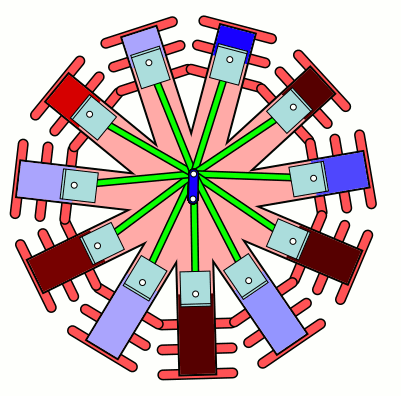Siemens-Halske Sh.III on:
[Wikipedia]
[Google]
[Amazon]
 The Siemens-Halske Sh.III was an 11-cylinder counter rotary engine. The Sh.III's
The Siemens-Halske Sh.III was an 11-cylinder counter rotary engine. The Sh.III's
Idflieg.com's Siemens Sh.III engine photos, by Andi Szekeres
Siemens Sh.III displayed at Museo Storico dei Motori e dei Meccanismi, University of Palermo (in Italian)
Front view
an
rear view
CAD-based animations of Sh.III internal engine components
YouTube 30 May 2020 video of Mikael Carlson's authentic Pfalz D VIII biplane reproduction on its maiden flight, with restored and flightworthy Sh III engine
{{Siemens-Halske aeroengines Air-cooled aircraft piston engines 1910s aircraft piston engines Rotary aircraft piston engines Siemens-Halske aircraft engines
Siemens-Halske
Siemens & Halske AG (or Siemens-Halske) was a German electrical engineering company that later became part of Siemens.
It was founded on 12 October 1847 as ''Telegraphen-Bauanstalt von Siemens & Halske'' by Werner von Siemens and Johann Geo ...
's Sh.III was an 11-cylinder, air-cooled counter rotary engine
The rotary engine is an early type of internal combustion engine, usually designed with an odd number of cylinders per row in a radial configuration. The engine's crankshaft remained stationary in operation, while the entire crankcase and it ...
developed in Germany during World War I
World War I (28 July 1914 11 November 1918), often abbreviated as WWI, was one of the deadliest global conflicts in history. Belligerents included much of Europe, the Russian Empire, the United States, and the Ottoman Empire, with fight ...
. The engine was a development of the earlier 9-cylinder Siemens-Halske Sh.I.
Design
 The Siemens-Halske Sh.III was an 11-cylinder counter rotary engine. The Sh.III's
The Siemens-Halske Sh.III was an 11-cylinder counter rotary engine. The Sh.III's propeller
A propeller (colloquially often called a screw if on a ship or an airscrew if on an aircraft) is a device with a rotating hub and radiating blades that are set at a pitch to form a helical spiral which, when rotated, exerts linear thrust upon ...
and cylinders
A cylinder (from ) has traditionally been a three-dimensional solid, one of the most basic of curvilinear geometric shapes. In elementary geometry, it is considered a prism with a circle as its base.
A cylinder may also be defined as an inf ...
were connected, these rotated anti-clockwise when viewed from the front of the aircraft (clockwise when viewed from the pilot’s seat) while the crankshaft
A crankshaft is a mechanical component used in a piston engine to convert the reciprocating motion into rotational motion. The crankshaft is a rotating shaft containing one or more crankpins, that are driven by the pistons via the connecting r ...
rotated clockwise.
The crankshaft was driven at 900 rpm via a set of bevel gears, located at the back of the engine, with a 2:1 ratio. The cylinders and propeller would have rotated at a speed of 1800 rpm anti-clockwise had the crankshaft been fixed. With the crankshaft rotating at 900 rpm clockwise the net propeller rotational speed was reduced to 900 rpm.
The counter rotary design allowed the engine to achieve the benefits of a high-power density from a high rotational speed while the propeller operated at a slower speed optimised for its design. By the end of WW1, operating the propeller at a slower speed than the engine had become normal practice for inline and V block engines but had proved difficult to accomplish on rotary engines.
Additional benefits of the counter rotary design were lower aerodynamic losses and reduced gyroscopic forces as the net cylinder rotational speed was reduced when compared to a conventional rotary of similar power output.
Unlike most rotary engines the Sh.III had a throttle
A throttle is the mechanism by which fluid flow is managed by constriction or obstruction.
An engine's power can be increased or decreased by the restriction of inlet gases (by the use of a throttle), but usually decreased. The term ''throttle'' ...
which could reduce engine speed to 350 rpm.
The Sh.III was intitally designed with a power output of 160 hp. A later variant, the Sh.IIIa, had a power output of 200 hp with some examples developing as much as 240 hp.
In operation the Sh.III suffered from poor reliability. The engine tended to overheat as the relatively slow rotation of the cylinders limited cooling air flow. Additionally, seizures of the engine were caused by poor lubrication as the Germans did not have access to castor oil
Castor oil is a vegetable oil pressed from castor beans.
It is a colourless or pale yellow liquid with a distinct taste and odor. Its boiling point is and its density is 0.961 g/cm3. It includes a mixture of triglycerides in which abo ...
which was one of the few oils that could retain its properties after being mixed with gasoline
Gasoline (; ) or petrol (; ) (see ) is a transparent, petroleum-derived flammable liquid that is used primarily as a fuel in most spark-ignited internal combustion engines (also known as petrol engines). It consists mostly of organic ...
.
Aircraft
* Albatros H.1 * Albatros D.XI * Pfalz D.VII * Pfalz D.VIII * LFG Roland D.IX * LFG Roland D.XVI * Siemens-Schuckert D.II * Siemens-Schuckert D.III * Siemens-Schuckert D.IV * Siemens-Schuckert D.VISpecifications
See also
*List of aircraft engines
This is an alphabetical list of aircraft engines by manufacturer.
0–9 2si
*2si 215
*2si 230
* 2si 430
*2si 460
* 2si 500
*2si 540
*2si 690
3W
''Source: RMV''
*3W 106iB2
*3W-110
*3W-112
*3W-170
*3W-210
*3W-220
A
Abadal (Franc ...
References
Further reading
*External links
Idflieg.com's Siemens Sh.III engine photos, by Andi Szekeres
Siemens Sh.III displayed at Museo Storico dei Motori e dei Meccanismi, University of Palermo (in Italian)
Front view
an
rear view
CAD-based animations of Sh.III internal engine components
YouTube 30 May 2020 video of Mikael Carlson's authentic Pfalz D VIII biplane reproduction on its maiden flight, with restored and flightworthy Sh III engine
{{Siemens-Halske aeroengines Air-cooled aircraft piston engines 1910s aircraft piston engines Rotary aircraft piston engines Siemens-Halske aircraft engines